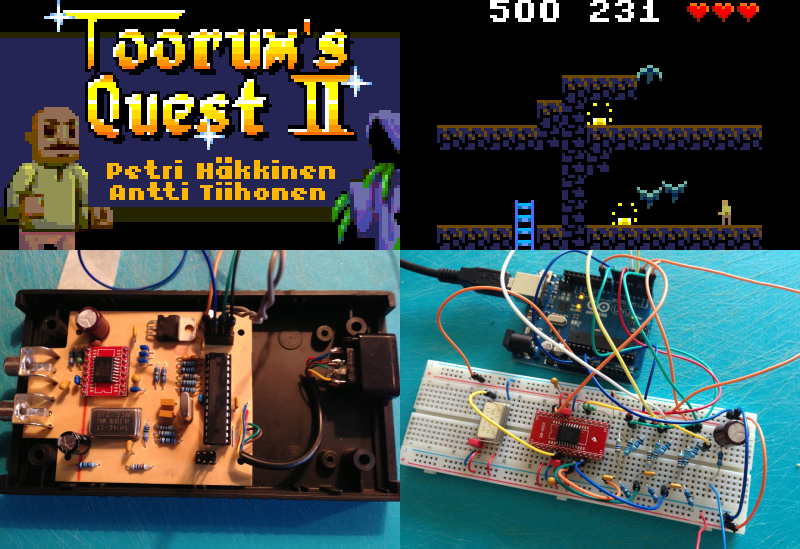[Petri] wrote in to show off the 8-bit gaming system and original platformer which he and [Antti] developed. Don’t get us wrong now, it’s impressive that the duo were able to put together what looks like a very interesting game. But we’ve seen many industry-leading video games developed with just one or two people (we’re thinking all the way back to the days of Atari). Nope, what’s most interesting to us is that the console is also their creation. We should note that the title screen was the work of their friend [Juho].
Take this with a grain of salt, as the bottom right image in the vignette obviously includes an Arduino. But isn’t it a testament to the state of open hardware and the sharing of knowledge through the Internet that this is even possible on the hobby level? And just because we call it “hobby” doesn’t mean you have to lower your expectations. This thing is full featured. Watch the clip after the break to see the ATmega328 driving a 104×80 resolution screen with a 256 color palette, while using four audio channels for the chiptunes. The thing even utilizes an original NES controller port for user input.
And for those of you who are thinking we’ve seen the same thing before, we never get tired of seeing projects where a lot of hard work has obviously paid off!















That’s really neat, I’ll be building one myself! The only thing i don’t get is… why if they’re etching a custom PCB, did they not just etch the footprint for a SOIC-16 instead of buying an adapter?
Ah, I see.. so they could hand draw the PCB.. neat :)
This is how Activision got started, sort of.
Very cool and, the graphics aside, this platform rivals even some sega master games :)
Seriously cool. Shoestring budget for the hardware – but Manolo Blahnik budget for the software. Good job there guys!
It looks more Uzebox than Hackvision.
Oh – I guess I should link to the uzebox for the benefit of people that don’t know about it
http://belogic.com/uzebox/index.asp
He even says it’s approximately a stripped down one (“Here’s the basic idea, inspired by Uzebox (which uses a more powerful MCU running at almost doubled clock rate btw.).”)
Pertinent differences: slower CPU and pixel clock, no SD or MIDI interfaces.
Silly differences: uses a NES controller instead of a SNES controller.
rj, was more that HaD linked back to HackVision in the “We’ve seen this before” rather than to their previous Uzebox stories.
They didn’t even include Uzebox in the related links.
Arduino isn’t really hobby only at all.
true, but id it defenatly is also a hobby.
I keep on wanting one of these “make your own video game with an atmel microcontroller” projects to borrow from lft and directly synthesize composite video on the Atmega, rather than relying on an external component→composite modulator.
Lots of great 8-bit options, my favorite being Rossum’s atmega microtouch, which apparently adafruit now sells..
In terms of 16-bit, the XGS PIC 16-Bit from andrew lamothe is quite complete!
Finally, 32-bit, Rossum does it again with the Rbox! Also gives you retro gaming on the most humbling of arm platforms!
Of course, there’s plenty of other hackvision, DavidCranor’s Thinner Client, etc, etc
The reason these guys’ game is so good is that they’re professional game developers. It’s a spin-off of their main game, Legend of Grimrock.
where I can download source code and another data of project?